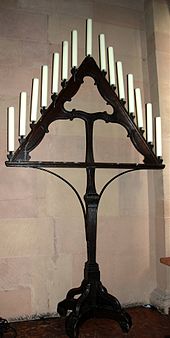Triangle (candlestick)

Various liturgical devices that are used in the liturgy of Holy Week are referred to as triangles or triangular chandeliers .
Tenebrae candlesticks in the bracelets
In the morning Karmetten the Kartage a Tenebrae Chandelier also Teneber candlestick or light rake (engl. Hearse ) used. The name is derived from the incipit of one of the responsories in Matutin on Good Friday : Tenebrae factae sunt, dum crucifixissent Jesum Judaei ("There was darkness when the Jews crucified Jesus", cf. Mt 27 : 45-46 EU ). Traditionally, this candlestick consists of a triangular piece of metal with devices for 15 candles arranged upwards. There are fourteen unbleached and one white candles on it. Light rakes are often used, which carry seven candles arranged in an ascending order and thus form a triangle. In addition, another, usually larger, candle can burn in the middle as a symbol for Christ .
At the beginning of the service, which today consists of Matins and Lauds , all candles are lit. A candle is extinguished after each psalm . At the end of the service only the Christ candle is burning. This top, white candle was before the reform of the Holy Week liturgy in the 1950s, an altar boy after the Benedictus of Lauds behind the altar ; after the subsequent oration it was put back on the tip of the triangle. The use of the triangle was retained even after the liturgical reform in the celebration of the carmets, albeit in a slightly different form.
In the course of liturgical history there have been various symbolic interpretations of the use of lights. The most widespread is the symbolic equation of the candles with the eleven apostles and the "three Marys" who told the disciples about the resurrection of Jesus Christ at Easter : Maria Cleophae , the mother of James, Maria Salome and Mary Magdalene .
Triangle chandelier on Easter night
Until the reform of the Holy Week liturgy from 1951 in the Easter Vigil liturgy, the light from the Easter fire was carried into the dark church by the deacon with a three-armed triangle candlestick ("a tube with three candles at its tip, arranged in a triangle"). During three stops on the way, one of the three candles was lit with the cry Lumen Christi - Deo gratias ("Christ, the light - thanks be to God"). In the church the triangular chandelier had its place by the steps of the altar, the Easter candle stood next to it.
In the Reformed liturgy of the Easter Vigil, the triangular chandelier was omitted. Since then, the Easter candle has been lit at the Easter fire and carried into the church.
literature
- Richard Kremser: The Holy Week ceremonies. Mödling near Vienna: Sankt-Gabriel-Verlag 1950, p. 11f
- Herbert Rauchenecker: Living customs. Munich: Pfeiffer 1985, p. 139
- Christoph Stiegemann: The Metten or Triangelleuchter, also called Teneber or Tenebraeleuchter , in: Das Münster 2008, issue 2
Web links
- Explanations of the cathedral parish of Mainz
- Entry in the Catholic Encyclopedia (1913) on Tenebrae Hearse (English)
Individual evidence
- ^ Missale Romanum XXVIII. (1920) p. 232 (PDF p. 336 v. 1220) ; Missale Romanum XXIX. (1953) p. 207.

